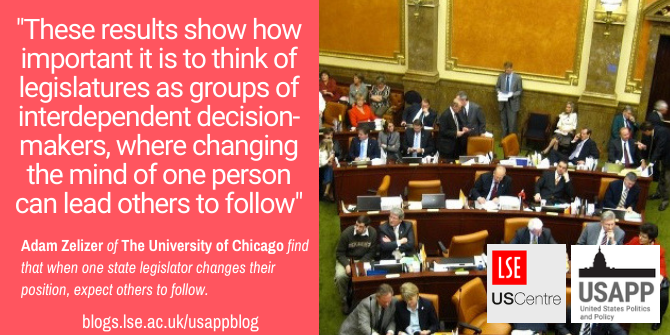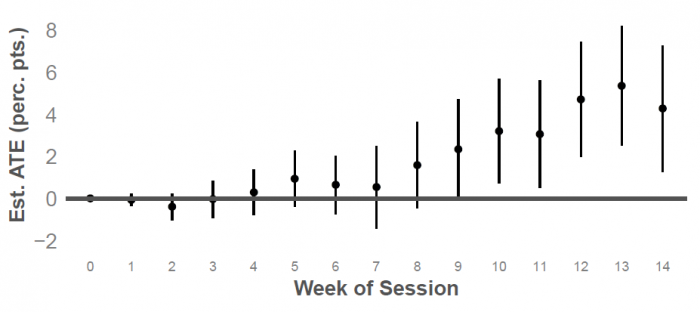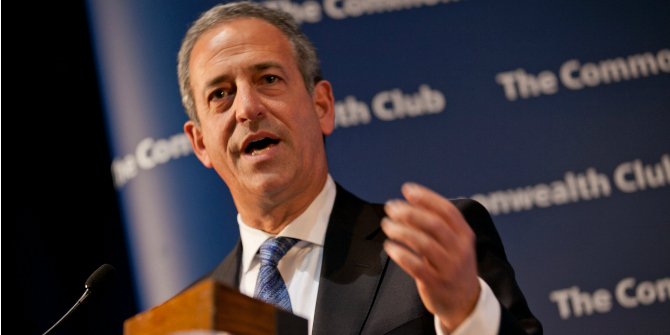 Representative democracy means that we trust legislators to make decisions for us on policies which we may not understand. But legislators themselves often may also have a limited understanding of the policies they need to decide. In new research, Adam Zelizer finds that legislators make up for this information gap by taking cues from their peers – other lawmakers. Changing one legislators’ mind, he writes, can lead others to follow.
Representative democracy means that we trust legislators to make decisions for us on policies which we may not understand. But legislators themselves often may also have a limited understanding of the policies they need to decide. In new research, Adam Zelizer finds that legislators make up for this information gap by taking cues from their peers – other lawmakers. Changing one legislators’ mind, he writes, can lead others to follow.
Every session, legislators in the state and federal governments consider thousands of policy proposals, covering a wide range of issues, under severe time constraints. It is simply not feasible for any individual to develop detailed knowledge about most proposals on the agenda. As a result, legislators often seem poorly informed about public policy. Nevertheless, legislators are expected to support bills that are popular with constituents and oppose those that are unpopular. They should create laws based on an expert, or at least passing, understanding of the policy. How do legislators fulfill their responsibilities if they are so uninformed?
Legislators can overcome their lack of knowledge on certain issues by relying on their peers. Legislators often give advice to one another about which position they should take. This guidance may range from relatively formal instructions from a party leader to less formal, or even inadvertent, behavior such as one legislator observing the vote of another. These diverse forms of peer influence are types of cue-taking, a process by which a decision-maker uses a shortcut to make a decision. Cues effectively allow legislators to cast informed votes even if they are not deeply informed about the policies at hand. Unsurprisingly, the most immediate source of these cues for legislators is their own peers.
Although it seems reasonable enough that legislators would work together in this way, it is difficult to demonstrate the extent to which cue-taking occurs. Cue-taking suffers from a common problem of peer influence in social settings: legislators who share cues with one another are likely to be similar. In other words, cues are shared between legislators who are most likely to agree with one another in the first place. This makes it difficult to estimate the causal effect of cues separately from legislators’ underlying similarities.

“Legislature” by Mike Renlund is licensed under CC BY NC SA 2.0
In recent research, I take a new approach to studying legislative cue-taking. The idea is to combine social network analysis with randomization-based research designs. In my research, State legislators were randomly assigned to receive a research report on bills on the legislative agenda. The reports were generated by legislative staff and contained technical information about legislation, like its projected cost to the state budget or the changes it would make to current government programs. Legislators were randomly assigned to receive reports on some bills and not others. Legislators were then free to support or oppose the bills as they wished. Because all of the bills related to veterans’ affairs, a broadly popular, bipartisan issue area, we expected information to help legislators support legislation.
In this legislature, most legislators shared offices with one or two peers. In these suites, assistants sat in a common anteroom beyond which each legislator had a private office. Legislators were largely allowed to self-select into suites without restriction from chamber leaders. As a result, officemates tended to be members of the same party, to represent similar if not neighboring districts, and to be friends.
Shared suites provide the framework for studying cue-taking. Suites are the social network across which cues are thought to be transmitted. Legislators in shared suites may be more likely to share cues with one another because legislators self-select into suites with similar peers, or because inhabiting a suite makes it easier for legislators to share information with one another.
Random assignment of the reports makes it possible to estimate cue-taking within legislative offices. Not only are legislators randomly assigned to either receive or not receive a report for a given bill, but they are randomly assigned to have their officemate receive or not receive a report. By randomizing legislators’ officemates to receive a report or not, we can estimate the effect of treating one legislator on the behavior of another. How exactly the influence spreads between legislators is unclear – it might be that the legislators have a lengthy conversation about the bill or share a quick recommendation in passing. Whatever the mechanism, the design identifies the effects of research reports as they spread between officemates.
How common, then, is cue-taking? Indirect effects of research are estimated to be 80 percent as large as direct effects. So, for every ten legislators convinced to support a bill with a research report, eight of their suitemates will also be convinced. Although outside the scope of this study, it is possible that legislators indirectly influenced by information may influence yet more legislators, and so on.
What about the process and timing of cue-taking? The dates on which legislators expressed support via cosponsorship, a mechanism that allows legislators to publicly indicate their support for a bill, is available via the state’s archives. In this legislature, legislative sessions last about fourteen weeks. Research reports were provided to legislators between weeks five and eight of the session. When did legislators express support of legislation, both when directly provided research and when exposed to research through officemates’ cues?
Figure 1 shows the estimated effects of research on the support of legislators who directly received it. Research begins to influence support around weeks 8 – 9, with their effects growing through week 13. As Figure 2 shows. cue-taking effects emerge later, around week 10 or even 12. From these data, it does not appear that cue-taking occurs immediately after legislators receive research. Instead, cue-taking occurs over time, as if legislators observe the positions of their peers and mirror them.
Figure 1 – Effects of receiving research on legislators’ support over time

Figure 2 – Cue-taking on legislators’ support over time

Legislators are not isolated, cut-off decision-makers. They work in a highly social, collegial environment. As a result, many their policy positions appear to be linked. These results show how important it is to think of legislatures as groups of interdependent decision-makers, where changing the mind of one person can lead others to follow.
- This article is based on the paper, “Is Position-Taking Contagious? Evidence of Cue-Taking from Two Field Experiments in a State Legislature”, in American Political Science Review.
Please read our comments policy before commenting.
Note: This article gives the views of the author, and not the position of USAPP – American Politics and Policy, nor the London School of Economics.
Shortened URL for this post: http://bit.ly/31xzP7z
About the author
 Adam Zelizer – The University of Chicago
Adam Zelizer – The University of Chicago
Adam Zelizer is an Assistant Professor at The University of Chicago Harris School of Public Policy. His research focuses on legislative politics, with an emphasis on causal inference.






